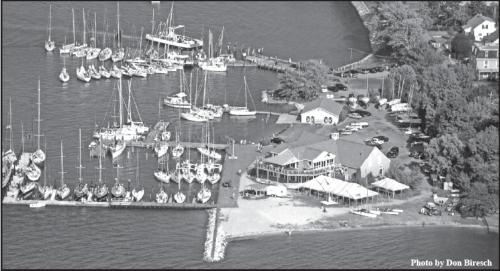
The Host Club
The year was 1931, the place was Oxford, Maryland on the Eastern Shore. Oxford offered all the natural resources for pleasant and relaxed living as weIl as playing. Town Creek and the Tred Avon and Choptank Rivers were just waiting to be enjoyed. In an effort to make available to the people an avenue to these great natural resources, a bath house was built on pilings near the water's edge. It was equipped with a sturdy rail procured from a ship salvage yard in Baltimore that gave the roof a salty and nautical look. A series of lights gave it a festive look. Upon this roof is where the organization of the Kap-Dun Club took place and later the Tred Avon Yacht Club was born.
Very shortly, membership climbed to over ninety members, the name Tred Avon Yacht Club was adopted and a new club burgee was adopted. Sailing regattas almost immediately became well known and well attended.
Over the years the members of TAYC have retained a spirit of belonging to a real team effort both on the water and on land. The natural resources provided by our location, the closeness among our members due to our common interest and mission, and our sincere delight in sharing our good fortunes with other sailors have always made this club unique. TAYC'ers take pride in welcoming sailors and hope that our weather and waters cooperate to make your visit one to remember.
The Area
Talbot County, with more than 600 miles of tidal shoreline, has been water-oriented since earliest times. Ringed by such rivers as the Choptank, Tuckahoe and Wye, it looks out on the west to Chesapeake Bay and is transected by the broad Miles, the beautiful Tred Avon, and countless smaller creeks and coves.
The quality of Talbot life has long reflected this maritime flavor. Its first English settlers, arriving in the 1650s, traveled by sloop, barge, priogue and Indian log canoe. Its first town, Oxford, developed as a port-of-call for English merchants whose ships traded finished goods for tobacco directly at the plantation wharves. Its shipbuilding center, St. Michaels, created the swift, sharp-hulled sailing vessels which became famous as the "Baltimore Clippers" of the War of 1812.
Founded in 1661 and named for Lady Grace Talbot, sister of the second Lord Baltimore, the county has ever since been the geographical and spiritual heartland of the Eastern Shore. Its county town, first called Talbot Court House and later Easton, was known as the "East Capital" of Maryland because the Eastern Shore's courts and governmental offices functioned there. Easton had the Shore's first bank, its first newspaper, its first Federal offices, its first brick hotel.
Talbot's early settlers were noted for independence and love of personal freedom, which remain hallmarks of the county's population today. Many were Quakers, seeking a haven from persecution; their Third Haven Meeting House, completed in 1684, still is in active service as a house of worship. Others were Puritans driven from Cavalier Virginia, or Irish and Scottish rebels transported to the colony as indentured servants. The county's blacks, coming as slaves, produced in Frederick Douglass, the nation's greatest 19th century exponent of freedom and justice for Negroes.
In colonial times Talbot politics and society were dominated by aristocratic families, the Lloyds, Tilghmans, Goldsboroughs, Hollydays and their marital allies, who had their principal seats of residence here. Their charming Georgian plantation houses, built on the waterfront, remain as graceful echoes of a vanished way of life.
Talbot citizens played key roles in the events leading to Maryland and American independence, and a citizen army headed by Gen. Perry Benson repelled a British attack on the town of St. Michaels in the War of 1812. In the Civil War the county was deeply divided. Post Civil War times found the county gaining national note as a site of summer homes for wealthy Northerners and a vacation resort for less affluent "summer boarders" from the nearby cities.
Along with products of the Bay, agriculture has always provided Talbot's chief source of income. First tobacco, then wheat, later tomatoes, fruit and truck crops, and in recent years corn, soybeans and poultry have sustained its basic population of sturdy family farmers.
Today retail trade and small industry are increasingly important, but much of the rural and maritime atmosphere of an earlier era lingers on. Easton is the Mid-Shore region's principal shopping center, but retains its mid-Victorian charm. Its splendid hospital, fine library and the county's excellent schools, public and private, make Easton one of Maryland's most attractive places to live. Oxford and St. Michaels are favorite ports of call for the world's yachtsmen; Tilghman Island is home base for one of the last oyster-dredging skipjack fleets on the Bay; Trappe district is an area of lovely homes tucked away on secluded coves.
Rooted deeply in the past, but looking progressively toward the future, Talbot County is proud of a way of life which seeks the best of both yesterday's and tomorrow's worlds.
Reprinted courtesy of the Tidewater Times magazine.
